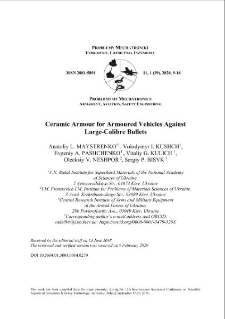Nasza Biblioteka Cyfrowa udostępnia 1 868 obiektów cyfrowych
Obiekt
Tytuł: Ceramic Armour for Armoured Vehicles Against Large-Calibre Bullets ; Ceramic Armour for Armoured Vehicles Against Large-Calibre Bullets
Współtwórca:
Volodymyr I. KUSHCH, Evgeniy A. PASHCHENKO, Vitaliy G. KULICH, Olecksiy V. NESHPOR, Sergiy P. BISYK ; Volodymyr I. KUSHCH, Evgeniy A. PASHCHENKO, Vitaliy G. KULICH, Olecksiy V. NESHPOR, Sergiy P. BISYK
Abstrakt:
Modelling the armour-piercing bullets B-32 calibre 12.7 mm penetration into the double-layer ceramic-composite armour has been performed for the armour blocks of two designs. The first one is a layer of ceramic square tiles supported by the glass or polyamide fabric. Modelling and subsequent ballistic tests have shown that the conical Hertz crack localized in the ceramic tile is formed. The tile is destroyed from the spread of radial cracks, and the entire armour unit becomes unable to sustain the repeated hit of the bullet. In the second case, the armour block consists of the discrete epoxy-filled cylindrical ceramic elements with spherical ends. The advantage of this "discrete" armour is localization of the damage zone and thus an ability to sustain the multiple bullet hits. The ballistic tests of the compared armour units have shown that both provide effective additional protection of light-armoured vehicles against the normal impact of the calibre 12.7 mm bullet.
;
Modelling the armour-piercing bullets B-32 calibre 12.7 mm penetration into the double-layer ceramic-composite armour has been performed for the armour blocks of two designs. The first one is a layer of ceramic square tiles supported by the glass or polyamide fabric. Modelling and subsequent ballistic tests have shown that the conical Hertz crack localized in the ceramic tile is formed. The tile is destroyed from the spread of radial cracks, and the entire armour unit becomes unable to sustain the repeated hit of the bullet. In the second case, the armour block consists of the discrete epoxy-filled cylindrical ceramic elements with spherical ends. The advantage of this "discrete" armour is localization of the damage zone and thus an ability to sustain the multiple bullet hits. The ballistic tests of the compared armour units have shown that both provide effective additional protection of light-armoured vehicles against the normal impact of the calibre 12.7 mm bullet.
Miejsce wydania:
Warszawa
;
Warszawa
Wydawca:
Wojskowa Akademia Techniczna ; Wojskowa Akademia Techniczna
Data utworzenia:
Data złożenia:
Data akceptacji:
Data wydania:
Rozmiar:
Identyfikator:
oai:ribes-88.man.poznan.pl:2572
Sygnatura:
DOI 10.5604/01.3001.0014.0279 ; DOI 10.5604/01.3001.0014.0279
ISSN elektroniczny:
ISSN drukowany:
Język:
Właściciel praw:
Wojskowa Akademia Techniczna ; Wojskowa Akademia Techniczna
Strona początkowa:
Strona końcowa:
Tom:
Słowa kluczowe:
reactive sintered silicon carbide, ceramic armour element, bullet, calibre, armour block, ballistic protection ; reactive sintered silicon carbide, ceramic armour element, bullet, calibre, armour block, ballistic protection
Kolekcje, do których przypisany jest obiekt:
Data ostatniej modyfikacji:
29 wrz 2025
Data dodania obiektu:
29 wrz 2025
Liczba wyświetleń treści obiektu:
0
Wszystkie dostępne wersje tego obiektu:
https://ribes-88.man.poznan.pl/publication/2888
Wyświetl opis w formacie RDF:
Wyświetl opis w formacie OAI-PMH:
| Nazwa wydania | Data |
|---|---|
| Ceramic Armour for Armoured Vehicles Against Large-Calibre Bullets | 29 wrz 2025 |

